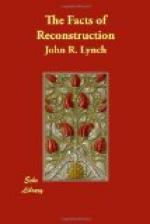It is needless to say that I was deeply interested in the President’s eloquent and prophetic talk which subsequent events have more than fully verified.
CHAPTER XV
THE PRESIDENTIAL ELECTION OF 1876 AND ITS RESULTS
The Presidential election was held in 1876. The Republicans had carried the country in 1872 by such a decisive majority that it indicated many years of continued Republican ascendency in the National Government. But the severe reverses sustained by that party at the polls two years later completely changed this situation and outlook. Democrats confidently expected and Republicans seriously apprehended that the Presidential election of 1876 would result in a substantial Democratic victory. Mr. Blaine was the leading candidate for the Republican nomination, but he had bitter opposition in the ranks of his own party. That opposition came chiefly from friends and supporters of Senator Conkling at the North and from Southern Republicans generally. The opposition of the Conkling men to Mr. Blaine was largely personal; while southern Republicans were opposed to him on account of his having caused the defeat of the Federal Elections Bill. The great majority of southern Republicans supported Senator Oliver P. Morton of Indiana.
After the National Convention had been organized, it looked for a while as if Mr. Blaine’s nomination was a foregone conclusion. Hon. Edward McPherson, of Pennsylvania,—a strong Blaine man,—had been made President of the Convention. In placing Mr. Blaine’s name in nomination, Hon. Robert G. Ingersoll of Illinois made such an eloquent and effective speech that he came very near carrying the Convention by storm, and thus securing the nomination of the statesman from Maine. But the opposition to Mr. Blaine was too well organized to allow the Convention to be stampeded, even by the power and eloquence of an Ingersoll. It was this speech that gave Mr. Ingersoll his national fame and brought him to the front as a public speaker and lecturer. It was the most eloquent and impressive speech that was delivered during the sitting of the Convention. After a bitter struggle of many hours, and after a number of fruitless ballots, the Convention finally nominated Gov. R.B. Hayes, of Ohio, as a compromise candidate. This result was brought about through a union of the combined opposition to Mr. Blaine. Hon. Wm. A. Wheeler, of New York, was nominated for Vice-President and the work of the Convention was over.
The Democrats nominated ex-Governor Samuel J. Tilden, of New York, for President, and Thomas A. Hendricks, of Indiana, for Vice-President. Their platform pledged many radical reforms in the administration of the government. This ticket was made with the hope that it would be successful in the doubtful and debatable States of New York, New Jersey, Indiana, and Connecticut, which, with the Solid South, would constitute a majority of the electoral college, even if all the other States should go Republican, which was not anticipated.




